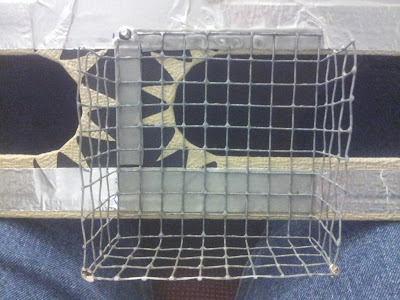1-24-13:
More
Speaker Stuff: You'll
note in the picture on my first post that my amp has this big 5" circle of
colored sticky-back foam right across the middle of the speaker area. I forgot
to mention that this is to counteract the "beam" effect of the
Celestion Vintage 30 speaker. When I was playing a gig last year, another
guitarist I know came by, and after helping check our overall band sound for
us, told me this during our next break. He said that when he was off to either
side of the stage, my guitar sounded fine, but when he walked across the front
of the stage, as he passed my amp, it had a particular "ice pick"
beaming effect, directly in front of my amp. Once he got a few feet off to
either side, it was fine. He said "You must be using a "Vintage
30". I said yes, and he said "Yeah, they're beamy like that".
So, when I looked into the "Beam Blocker" things you can buy, I
didn't want to pull my speaker back out of the cabinet to install one. I did
some reading, and found that Stevie Ray Vaughan used to put duct tape on his
speaker cabinets with Vintage 30's, in the shape of an "X" over the
center cone area. I wanted to do something just a little more
"Classier" than that, so I came up with the sticky-back foam sheet
stuff, in a 5" circle. I experimented with 3" & 4" circles,
but couldn't decide if all of the "beamyness" was gone yet. I decided
on a 5" circle. I knew for certain with the 5" circle, I'd gotten rid
of all of the "beamyness". The initial problem was the
sticky-back stuff didn't really have the staying power necessary to keep it in
place. I used some 3/4" wide x 1/16" thick foam double-stick tape. I
cut about 4 - 3" pieces, and used some scissors to cut slits (most of the
way across) about every 1/2" apart. Then I took the piece of tape, and
bent it around the outer 5" circle of foam sheet, sort of like fanning out
the piece of tape at all of the slits. I removed the other tape backing
material when all of the tape pieces were in place. Then I centered the foam
sheet circle over the speaker cone, and gently pressed it into place, going
around the outer edge of the circle. I probably stuck one 1" square piece
right in the middle of the foam, to help hold it in place better.
It has stayed in place well, and that same
friend has heard us play at other gigs since that first time, and he said my
guitar rig sounds great anywhere in the room where we're playing. Also, I have
our band name on the front. A shameless plug: www.DeltaFusionBand.com . We play
local clubs in the Loveland & Ft. Collins, CO area, as well as the northern
Denver area.
6L6 Tube Protector:
One thing I liked on the later Fender HRD amps was the 6L6 Tube Protector cage
that was now included on the back cover of the amp. The reason I like this
feature is because when gigging, I always us an external speaker cabinet.
Reaching under the back cover with a heavy metal ¼” plug, I've banged that plug
up against the side of the 6L6 power tube. I've never broken one (yet), but I've come close a couple of times when in a hurry, and I’m packin’ up after a gig,
and I try to pull that plug out quickly (but carefully), and I hear it hit the
tube.
I made a protector cage out of ½” hardware
grid wire as shown below. The dimensions are 4 1/2" W x 4" H x 2 " D. There is an extra 1/2" tab at the top of the mounting side, to help pinch the cage between the chassis edge and the back cover. I attached the cage to the back cover using some gray
thin foam double-stick tape, which has worked our well. Since the back cover
spends most of its life screwed to the back of the amp, the cage isn't going to
fall or slip out of place.






